Search Result
Results for "
lesions
" in MedChemExpress (MCE) Product Catalog:
2
Biochemical Assay Reagents
3
Isotope-Labeled Compounds
| Cat. No. |
Product Name |
Target |
Research Areas |
Chemical Structure |
-
- HY-13977A
-
|
|
Apoptosis
|
Neurological Disease
|
|
PKR-IN-C16 (Compound C16) is a specific double-stranded RNA-dependent protein kinase (PKR) inhibitor. PKR-IN-C16 shows promising neuroprotective properties and can rescue acute brain lesions .
|
-
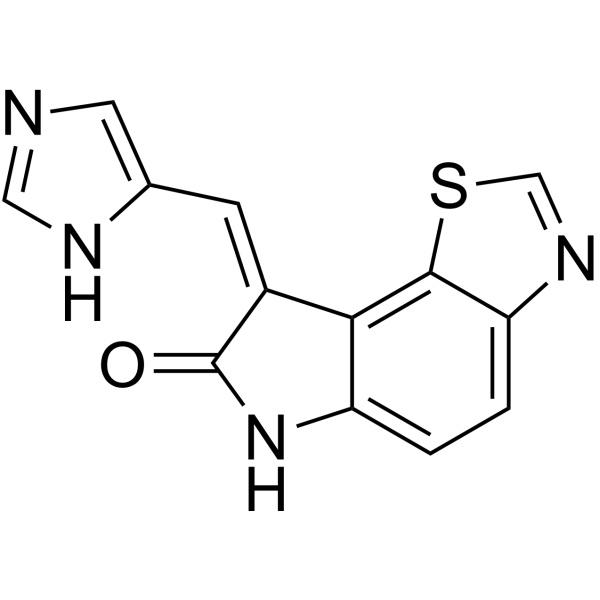
-
- HY-133598
-
|
|
Others
|
Cancer
|
|
3,4,5-Trichlorocatechol is a catechol derivative of pentachlorophenol and induces oxidative DNA lesions .
|
-

-
- HY-P5890
-
-

-
- HY-107248
-
|
|
Others
|
Inflammation/Immunology
|
|
Escin IIa, isolated from horse chestnut, the seeds of Aesculus hippocastanum L., has positive effects on acute inflammation in animals. Escin IIa has gastroprotections on ethanol-induced gastric mucosal lesions in rats .
|
-
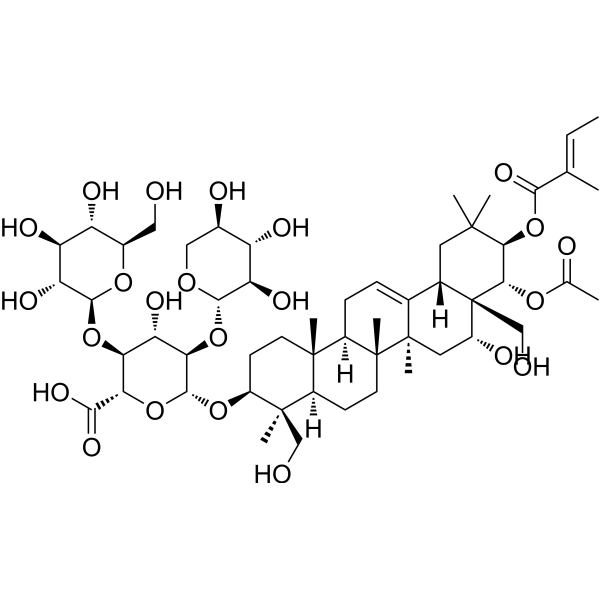
-
- HY-107247
-
|
|
Others
|
Inflammation/Immunology
|
|
Escin IIb, isolated from horse chestnut, the seeds of Aesculus hippocastanum L., has positive effects on acute inflammation in animals . Escin IIb showed potent protective effects against ethanol-induced gastric mucosal lesions .
|
-

-
- HY-18664
-
PFI-4
1 Publications Verification
|
Epigenetic Reader Domain
|
Cancer
|
|
PFI-4 (compound 11) is a potent and highly selective BRPF1 Bromodomain (BRPF1B) inhibitor, with an IC50 of 172 nM. PFI-4 can be used to explore the functional mechanisms of the HBO1/BRPF1 complex and to study bone loss and osteolytic malignant bone lesions .
|
-
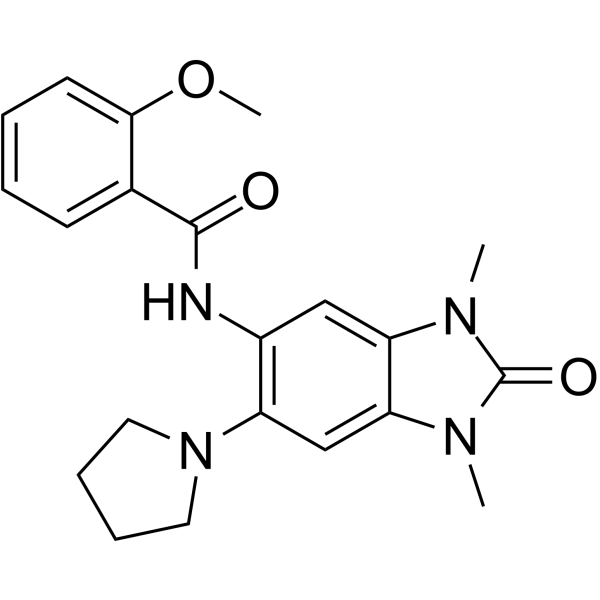
-
- HY-110161
-
|
|
Somatostatin Receptor
|
Cardiovascular Disease
Endocrinology
|
|
sst2 Receptor agonist-1 is a potent somatostatin receptor subtype 2 (sst2) agonist with a Ki value of 0.025 nM and a cAMP IC50 value of 4.8 nM. sst2 Receptor agonist-1 can inhibit rat growth hormone (GH) secretion and ocular neovascular lesion formation. Antiangiogenic effect .
|
-

-
- HY-142521
-
|
|
Leukotriene Receptor
|
Metabolic Disease
|
|
BLT2 probe 1 (compound 13) is a fluorescent probe based on the synthetic BLT2 agonist CAY10583. BLT2 is a promising target for diabetic wound healing and gastrointestinal lesions. BLT2 probe 1 is suitable to investigate the pharmacology of BLT2 receptor ligands in a variety of assay systems .
|
-

-
- HY-147313
-
|
|
Others
|
Metabolic Disease
Cancer
|
|
TH10785 is a DNA glycosylase 1 (OGG1) activator, TH10785 can interact with the phenylalanine-319 and glycine-42 amino acids of OGG1 and increase the enzyme activity, generates β, δ-lyase enzymatic function. TH10785 can control the catalytic activity mediated by a nitrogen base within its molecular structure. TH10785 can be used for the research of various diseases and aging connected with DNA oxidative lesions .
|
-
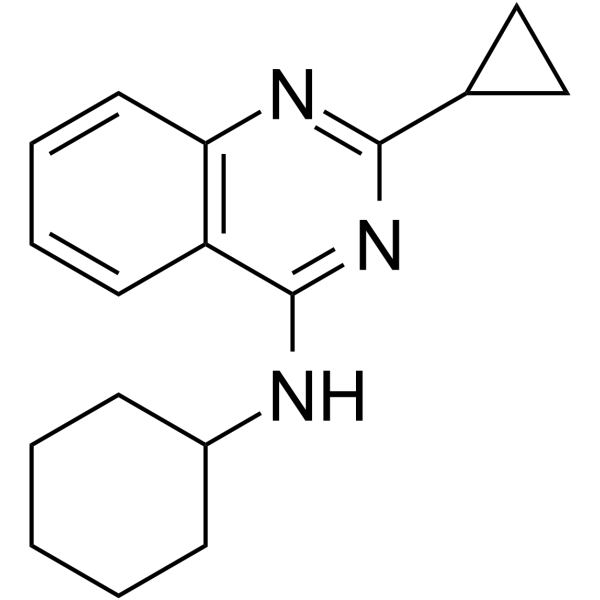
-
- HY-W010697
-
-
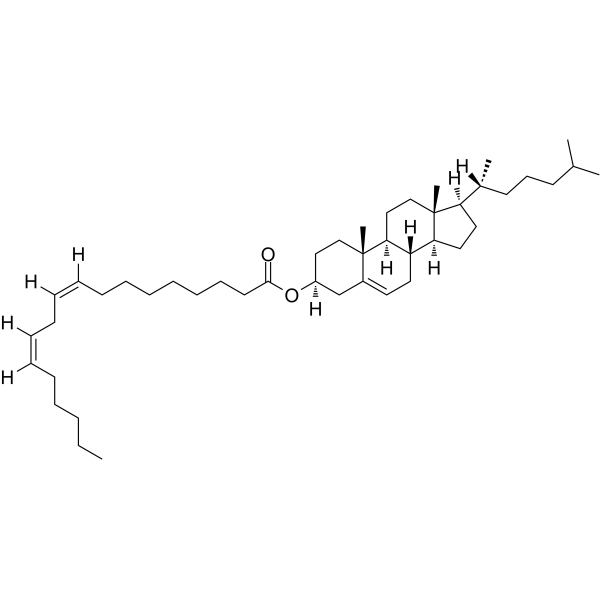
-
- HY-W013812
-
|
Linoleic Acid ethyl ester; Mandenol
|
Others
|
Cardiovascular Disease
|
Ethyl linoleate (Linoleic Acid ethyl ester) inhibit the development of atherosclerotic lesions and the expression of inflammatory mediators .
|
-
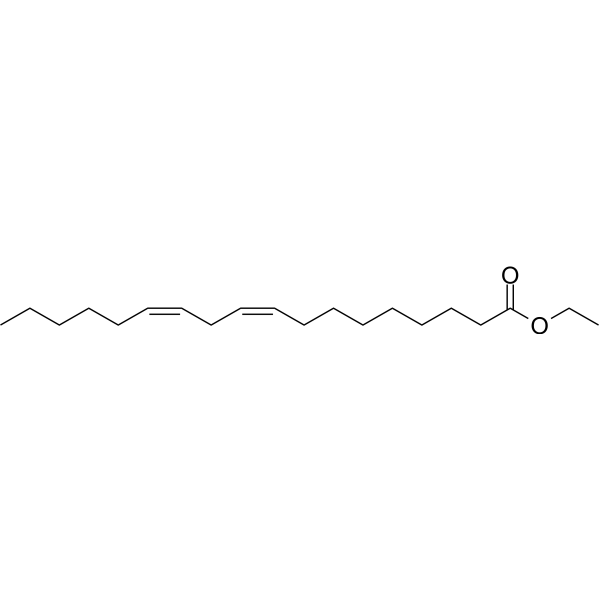
-
- HY-W144308
-
|
TCHQ; Tetrachloroquinol
|
Drug Metabolite
Reactive Oxygen Species
|
Others
|
|
Tetrachlorohydroquinone (TCHQ) is a metabolite of pentachlorophenol. Tetrachlorohydroquinone increases DNA lesions and induce oxidative stress in rodents .
|
-
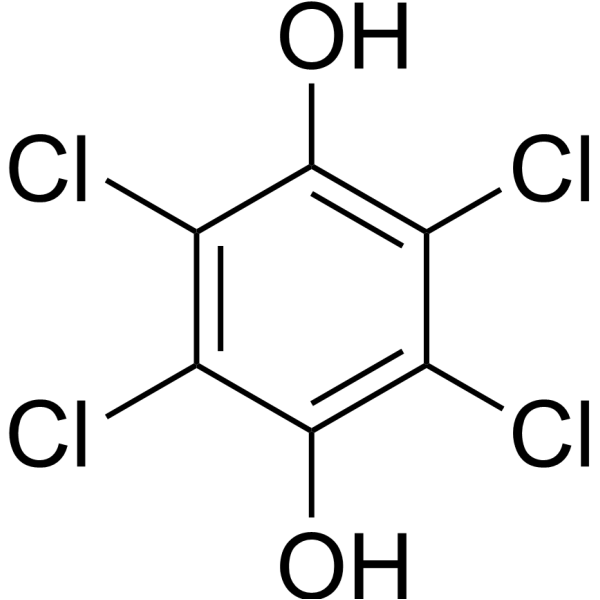
-
- HY-113338
-
|
|
Endogenous Metabolite
|
Others
|
|
8-Hydroxyguanine is a major pre-mutagenic lesion generated from reactive oxygen species. It causes G-T and A-C substitutions.
|
-
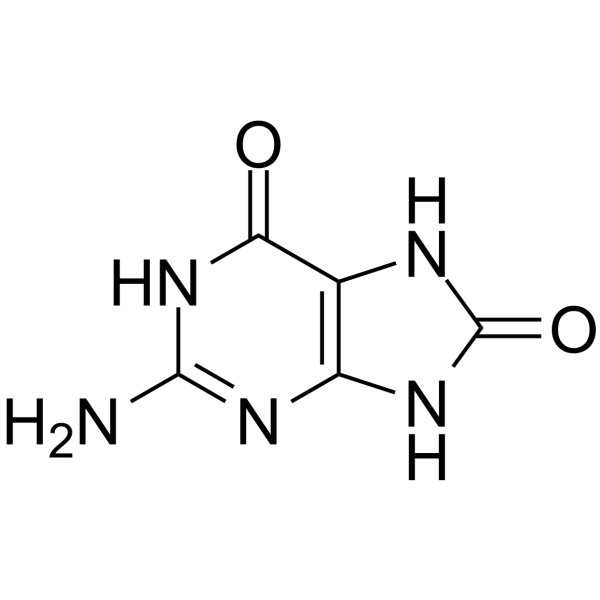
-
- HY-B1745
-
|
|
|
|
|
Pyridoxylamine is an advanced glycation end production (AGEs) and lipoxidation end products (ALEs) inhibitor, to protect against diabetes-induced retinal vascular lesions.
|
-
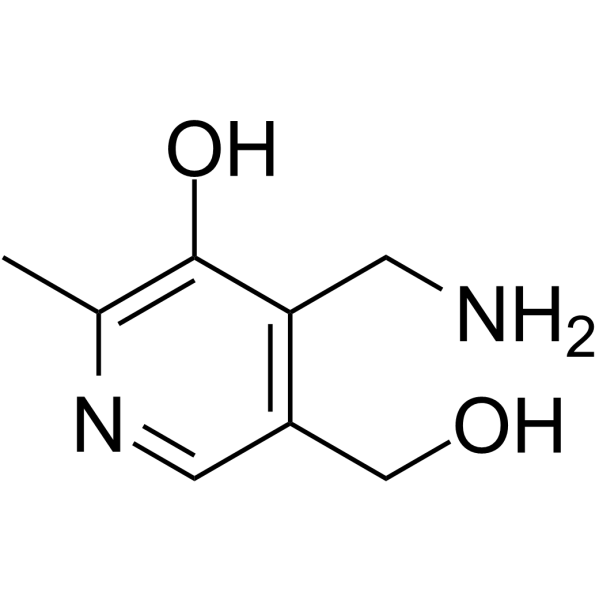
-
- HY-B1745A
-
|
|
|
|
|
Pyridoxylamine dihydrochloride is an advanced glycation end production (AGEs) and lipoxidation end products (ALEs) inhibitor, to protect against diabetes-induced retinal vascular lesions .
|
-
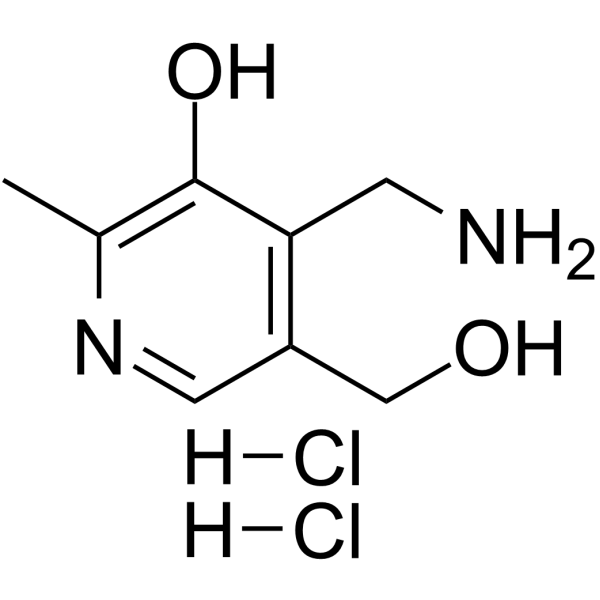
-
- HY-17644
-
|
LUZ11; F2BMet
|
|
|
|
Redaporfin (LUZ11) acts as a potent photosensitizer. Redaporfin causes direct antineoplastic effects as well as indirect immune-dependent destruction of malignant lesions .
|
-

-
- HY-W013812S
-
|
Linoleic Acid-13C18 ethyl ester; Mandenol-13C18
|
Isotope-Labeled Compounds
|
Cardiovascular Disease
|
Ethyl linoleate- 13C18 is the 13C labeled Ethyl linoleate. Ethyl linoleate inhibit the development of atherosclerotic lesions and the expression of inflammatory mediators[1].
|
-

-
- HY-D1494
-
|
|
Amyloid-β
|
Neurological Disease
|
|
FSB is a fluorescent dye that can be used to detect filamentous tau and to label human amyloid lesions with high sensitivity and specificity (excitation: 390 nm, emission: 520 nm) .
|
-

-
- HY-154988
-
|
|
Others
|
Neurological Disease
Cancer
|
|
MARK4 inhibitor 4 is a MARK4 inhibitor with an IC50 of 1.49 μM. MARK4 inhibitor 4 can be used in cancer and tau lesion-related research .
|
-
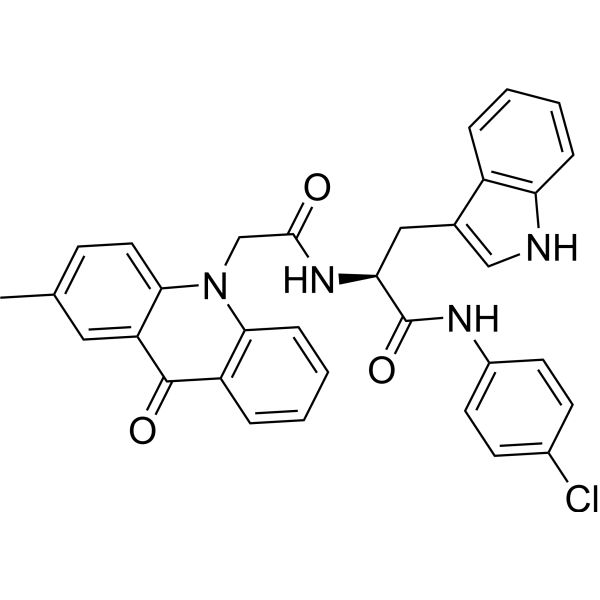
-
- HY-139579
-
|
OTL 38
|
Fluorescent Dye
|
Cancer
|
|
Pafolacianine (OTL 38) is a fluorescent marker made of near-infrared dye used in detecting tumor lesions during surgical procedures. Pafolacianine excites at 774 to 775 nm and emits at 794 to 796 nm .
|
-
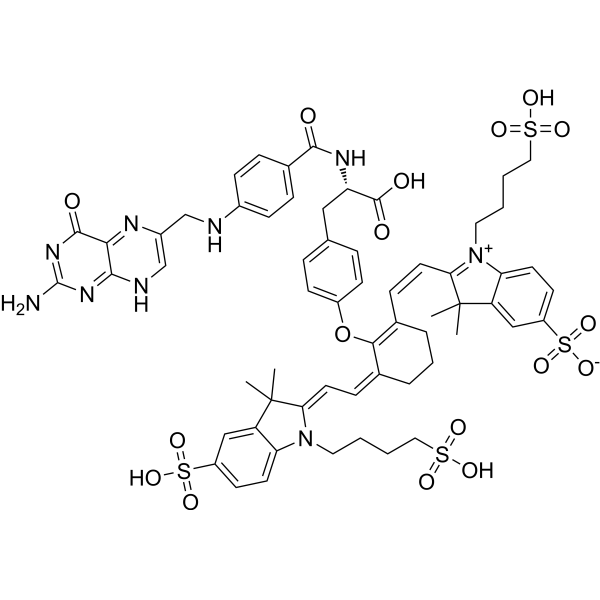
-
- HY-111940
-
|
|
Raf
|
Inflammation/Immunology
|
|
LUT014 is a B-Raf inhibitor with an IC50 of 11.7 nM, and developed to reduce dose-limiting acneiform lesions associated EGFR Inhibitors treatment. Extracted from patent WO 2019026065A2 .
|
-
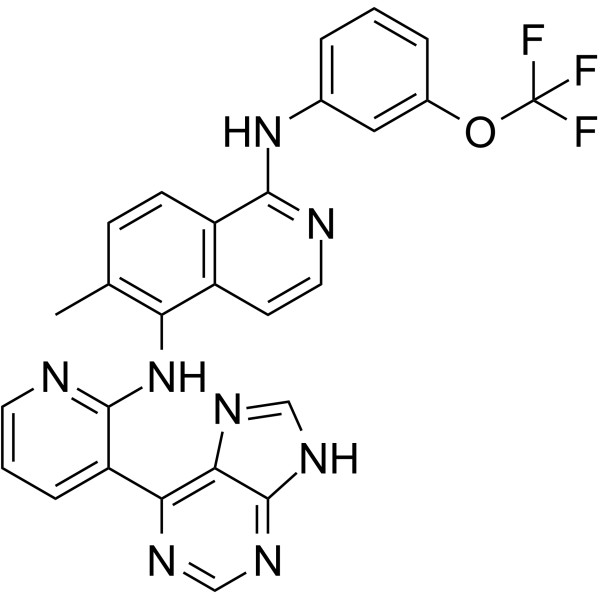
-
- HY-108038
-
|
|
nAChR
|
Neurological Disease
|
|
ABT-107 is a selective α7 neuronal nicotinic receptor agonist. ABT-107 protects against nigrostriatal damage in rats with unilateral 6-hydroxydopamine lesions .
|
-
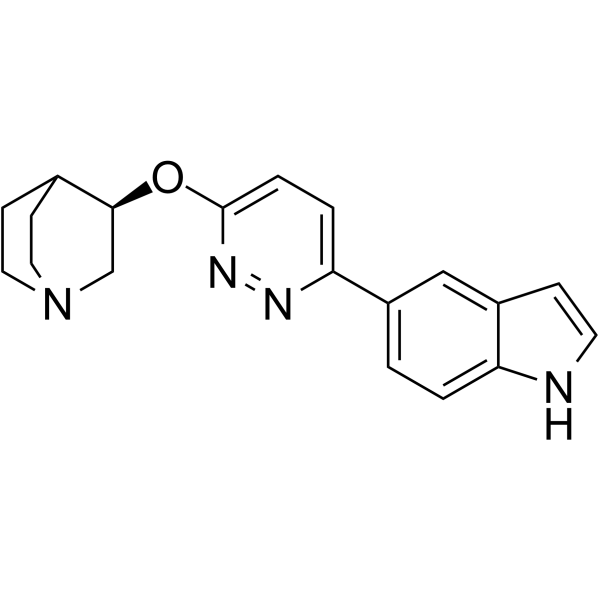
-
- HY-150042
-
|
|
YAP
|
Cardiovascular Disease
Others
|
|
TDI-011536 is a potent Lats kinase inhibitor, interrupts Hippo-Yap signaling and initiates the proliferation of lesioned heartmuscle cells. TDI-011536 can be used in studies of organ conservation and regeneration .
|
-

-
- HY-13703A
-
|
ACNU
|
DNA/RNA Synthesis
DNA Alkylator/Crosslinker
Apoptosis
|
Cancer
|
|
Nimustine hydrochloride (ACNU) is a DNA cross-linking and DNA alkylating agent, which induces DNA replication blocking lesions and DNA double-strand breaks and inhibits DNA synthesis, commonly used in chemotherapy for glioblastomas .
|
-
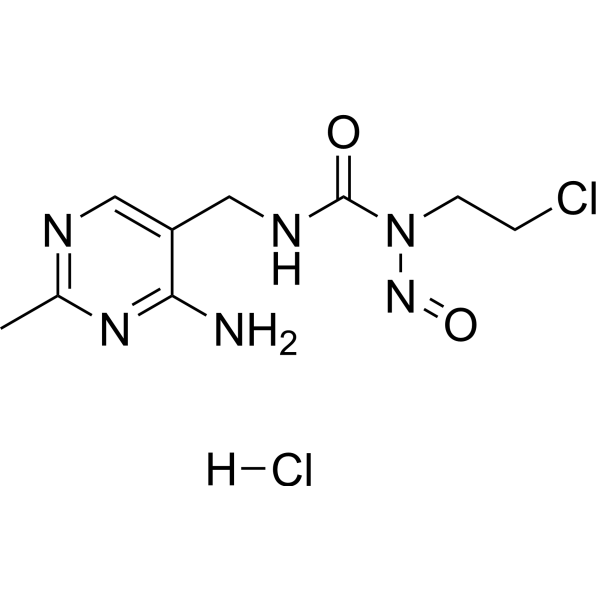
-
- HY-135014
-
|
|
Melanocortin Receptor
Adrenergic Receptor
|
Others
|
|
Undecylenoyl phenylalanine is an antagonist for α-melanocyte-stimulating hormone (MSH) and β-adrenergic receptor (β-ADR) to reduce the melanogenesis in melanocytes, reduces hyperpigmentation and thus ameliorates melasma lesions and solar lentigines .
|
-

-
- HY-131468
-
|
AMD473; ZD0473
|
Others
|
Cancer
|
|
Picoplatin (AMD473) is a platinum-based antineoplastic agent. Picoplatin is specifically to circumvent thiol-mediated drug resistance by sterically hindering its reaction with glutathione (GSH) while still retaining the ability to form cytotoxic lesions with DNA .
|
-
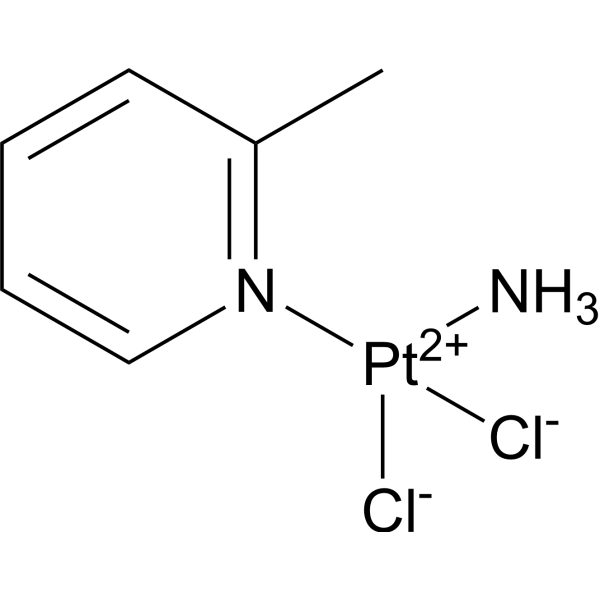
-
- HY-D1443
-
|
(trans,trans)-1-Bromo-2,5-bis-(3-hydroxycarbonyl-4-hydroxy)styrylbenzene
|
Amyloid-β
|
Others
|
|
BSB is a Congo red-derived fluorescent probe. BSB binds not only to extracellular amyloid β protein, but also many intracellular lesions composed of abnormal tau and synuclein proteins. BSB acts as a prototype imaging agent for Alzheimer's disease .
|
-
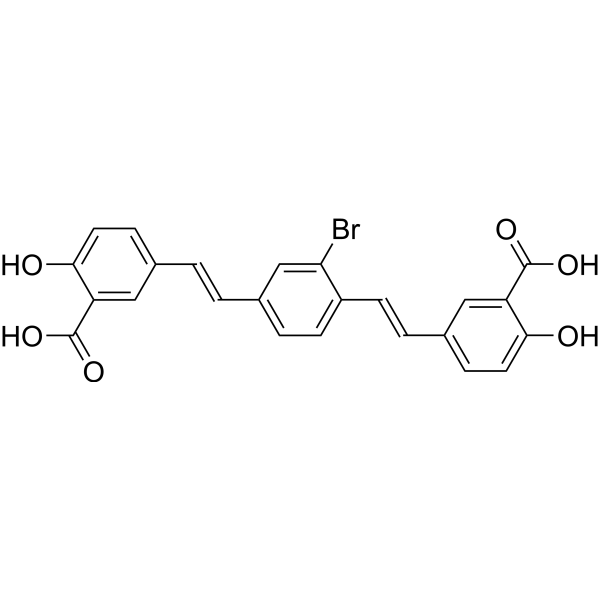
-
- HY-147230
-
|
|
Histone Methyltransferase
|
Cancer
|
|
EZH2-IN-13 is a potent EZH2 inhibitor, for details please refer to compound 73 in patent WO2017139404. EZH2-IN-13 can be used to study cancers or precancerous lesions associated with EZH2 activity .
|
-

-
- HY-128760
-
COH34
1 Publications Verification
|
Poly(ADP-ribose) Glycohydrolase (PARG)
|
Cancer
|
|
COH34 is a potent and specific poly(ADP-ribose) glycohydrolase (PARG) inhibitor with an IC50 of 0.37 nM. COH34 binds to the catalytic domain of PARG (Kd=0.547 μM), thereby prolonging PARylation at DNA lesions and trapping DNA repair factors .
|
-
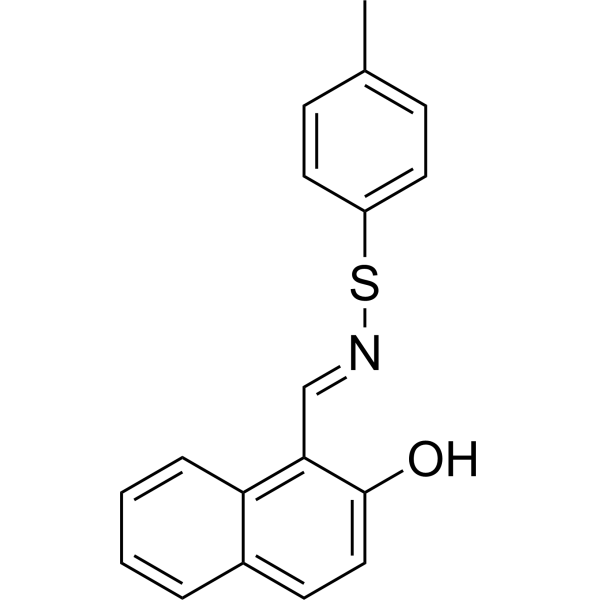
-
- HY-N1553
-
|
|
|
|
|
Pseudolaric acid D is a compound with oral activity that can be isolated from Pseudolarix kaempferi Gorden. Pseudolaric acid D can significantly improve lipid metabolism, reduce atherosclerotic lesion area, and alleviate atherosclerotic changes in vascular wall. Pseudolaric acid D significantly inhibits the inflammatory reaction .
|
-
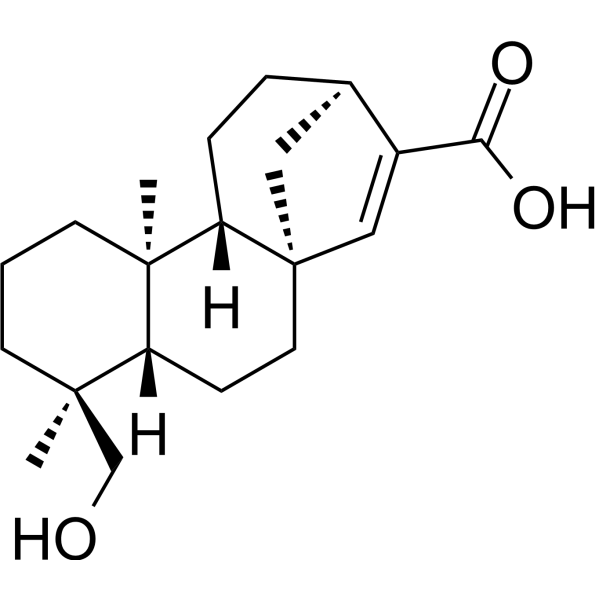
-
- HY-W013812S2
-
|
Linoleic Acid ethyl ester-d2; Mandenol-d2
|
Isotope-Labeled Compounds
|
Cardiovascular Disease
|
|
Ethyl linoleate-d2 (Linoleic Acid ethyl ester-d2; Mandenol-d2) is the deuterium labeled Ethyl linoleate (HY-W013812). Ethyl linoleate (Linoleic Acid ethyl ester) inhibit the development of atherosclerotic lesions and the expression of inflammatory mediators .
|
-
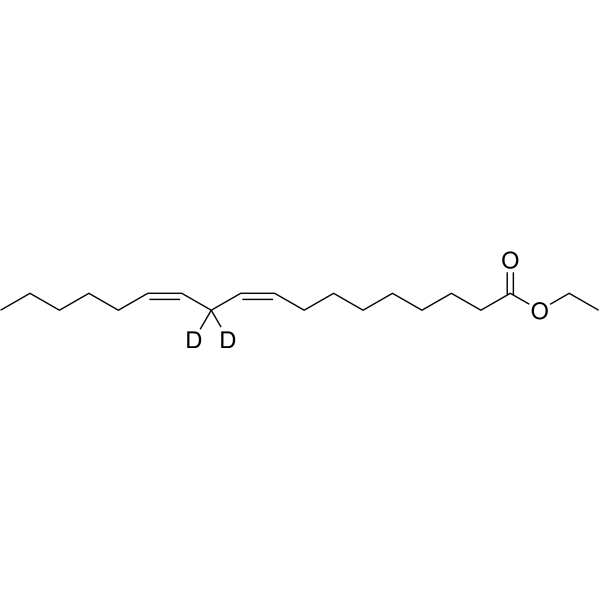
-
- HY-156466
-
|
|
JAK
|
Inflammation/Immunology
|
|
QL-1200186 is anorally activeand selective inhibitor ofTYK2. Oral administration of QL-1200186, dose-dependently inhibitsinterferon-γ(IFNγ) production afterinterleukin-12(IL-12) challenge and significantly ameliorates skin lesions in psoriatic mice .
|
-

-
- HY-100413
-
|
|
|
|
|
CS-526 is a potent, selective, reversible and orally active acid pump antagonist. CS-526 inhibits H +,K +-ATPase activity. CS-526 inhibits gastric acid secretion and prevents esophageal lesions. CS-526 has the potential for the research of gastroesophageal reflux disease .
|
-
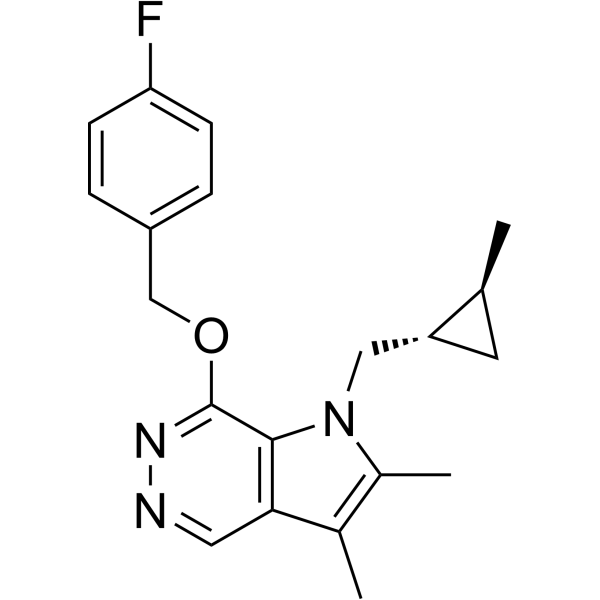
-
- HY-129214
-
-
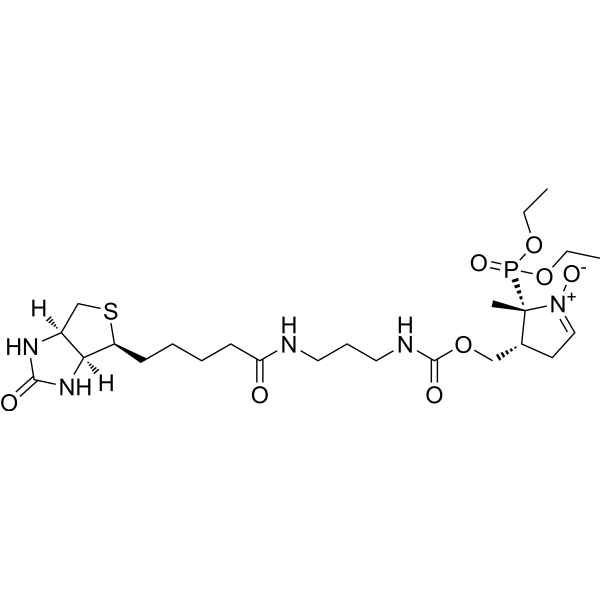
-
- HY-B1496
-
|
SKF 385 hemisulfate
|
Monoamine Oxidase
Histone Demethylase
|
Neurological Disease
|
|
Tranylcypromine (SKF 385) hemisulfate is an irreversible, nonselective monoamine oxidase (MAO) inhibitor used in the treatment of depression. Tranylcypromine hemisulfate is also a lysine-specific demethylase 1 (LSD1) inhibitor, suppresses lesion growth and improves generalized hyperalgesia in mouse with induced endometriosis. Tranylcypromine has antidepressant effects .
|
-
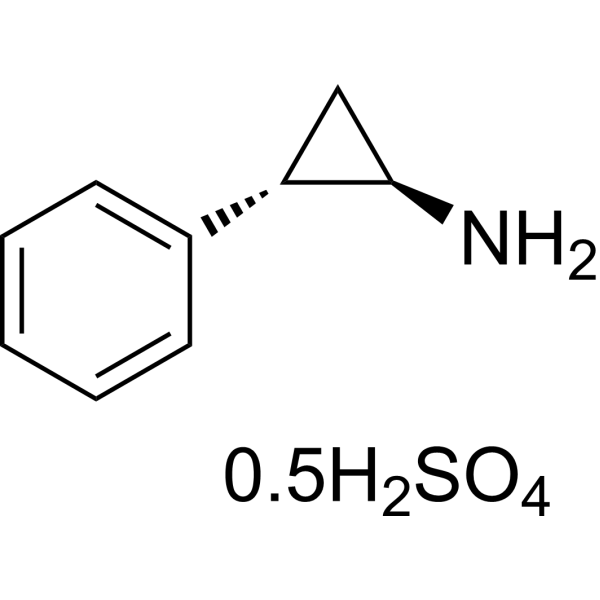
-
- HY-123026
-
|
|
Bacterial
|
Infection
|
|
Salannin, a limonoid bitter principle of the seed oil of Azadirachta indica, shows antiulcer and spermicidal activities. Salannin displays antibacterial activity towards both Gram-positive and Gram-negative bacteria .
|
-
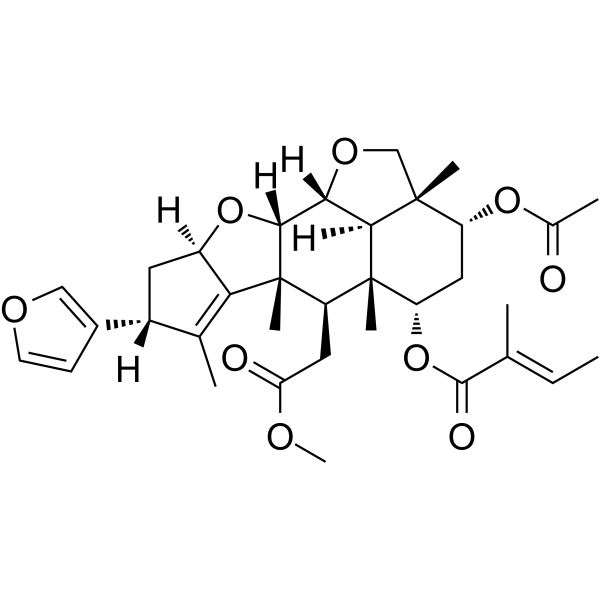
-
- HY-125098
-
|
|
DNA Alkylator/Crosslinker
Apoptosis
|
Infection
Cancer
|
|
Illudin S, a cytotoxic Illudin, is a natural sesquiterpene with strong anti-tumour and antiviral activities. Illudin S has genotoxic activities. Illudin S blocks the G1-S phase interface of the cell cycle in human leukemia cells .
|
-

-
- HY-17447SA
-
|
SKF 385-d5 hydrochloride
|
Monoamine Oxidase
Histone Demethylase
|
Neurological Disease
|
|
Tranylcypromine-d5 (hydrochloride) is a deuterium labeled (rel)-Tranylcypromine hydrochloride. Tranylcypromine hydrochloride is an irreversible, nonselective monoamine oxidase (MAO) inhibitor used in the treatment of depression. Tranylcypromine hydrochloride is also a lysine-specific demethylase 1 (LSD1) inhibitor, suppresses lesion growth and improves generalized hyperalgesia in mouse with induced endometriosis[1][2].
|
-

-
- HY-B0025
-
|
|
Glucosidase
|
Metabolic Disease
|
|
Voglibose is an orally active alpha-glucosidase inhibitor that prevents the development of colorectal precancerous lesions induced by obesity and diabetes. Voglibose reduces oxidative stress in an inflammatory environment and inhibits the insulin-like growth factor/insulin-like growth factor-1 receptor (IGF/IGF-1R) functional axis.
|
-
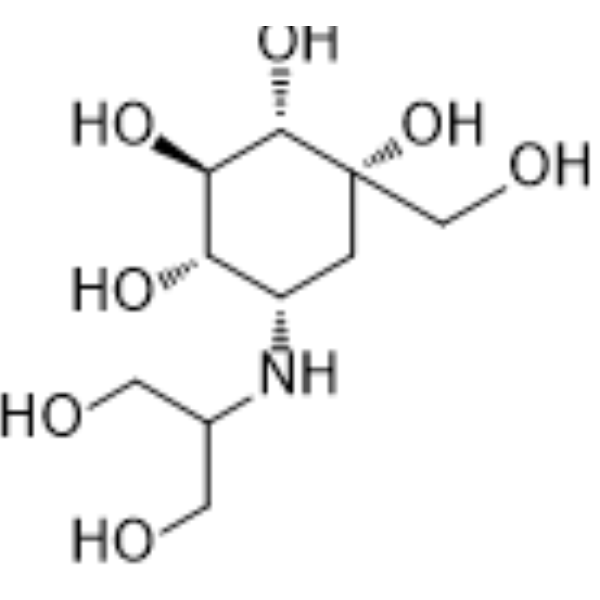
-
- HY-16219
-
|
Gd-EOB-DTPA Disodium; ZK 139834
|
Biochemical Assay Reagents
|
Cancer
|
|
Gadoxetate Disodium (Gd-EOB-DTPA Disodium) is a contrast agent in magnetic resonance imaging (MRI) of the hepatobiliary system, which accumulates in normal, functioning hepatocytes. Gadoxetate Disodium (Gd-EOB-DTPA Disodium) is used to evaluate focal liver lesions, such as hepatocellular carcinoma or liver metastasis on T1-weighted imaging .
|
-

-
- HY-157916
-
|
Aldehyde reactive probe
|
Fluorescent Dye
|
Others
|
|
ARP (Aldehyde reactive probe) is an aldehyde reactive probe for detecting abasic site (common DNA lesions and intermediates in mutagenesis and carcinogenesis) in DNA, which specificially tags AP site with biotin residues. ARP is highly sensitive with a femtomolar-level basic site detection capabilities (less than one site per 10 4 nucleotides) .
|
-

-
- HY-N0351
-
|
trans-4-Hydroxycinnamic acid
|
Endogenous Metabolite
Bacterial
Apoptosis
|
Inflammation/Immunology
Cancer
|
|
p-Coumaric acid (trans-4-Hydroxycinnamic acid) is an isomer of cinnamic acid with oral activity. p-Coumaric acid inhibits cell proliferation and promotes apoptosis. p-Coumaric acid has antibacterial, anti-inflammatory, antioxidant and anti-tumor activities .
|
-
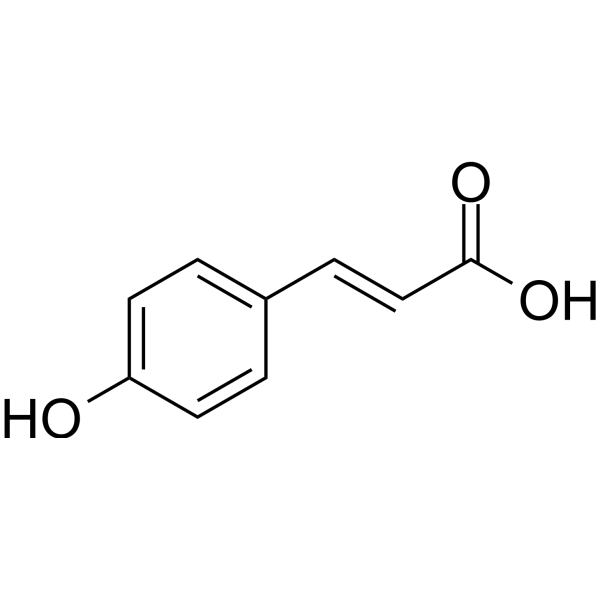
-
- HY-103197
-
|
RX821002 hydrochloride
|
Adrenergic Receptor
|
Neurological Disease
|
|
2-Methoxyidazoxan monohydrochloride (RX821002 hydrochloride) is a highly selective alpha 2-adrenoceptor antagonist with little or no imidazoline antagonist effect. RX 821002 has markedly higher affinity for (guinea-pig) alpha 2D-adrenoceptors (pKd 9.7) than for (rabbit) alpha 2A-adrenoceptors (pKd 8.2) .
|
-
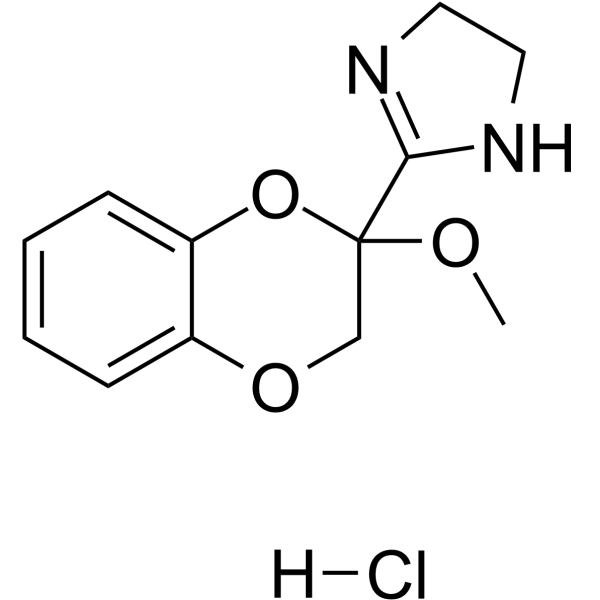
-
- HY-120893
-
|
|
Others
|
Others
|
|
trans-4,5-Epoxy-(E)-2-decenal is an oxygenated α,β-unsaturated aldehyde found in mammalian blood that gives blood its characteristic metallic odor. It is used by predators to locate blood or prey .
|
-
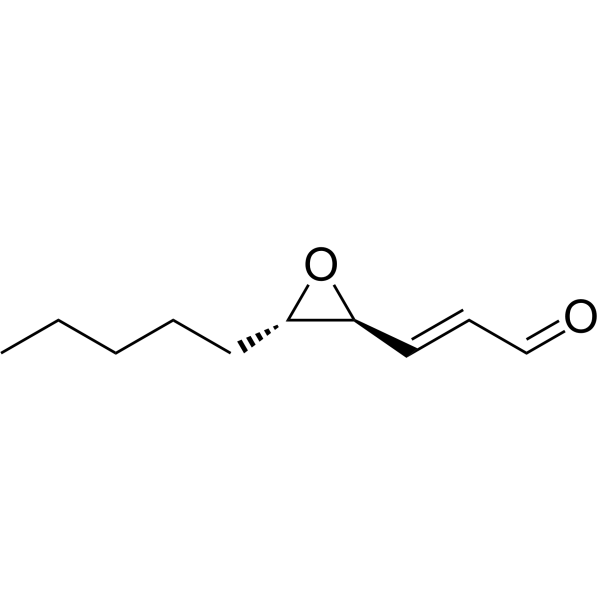
-
- HY-W027951
-
|
DMTU
|
Reactive Oxygen Species
|
Inflammation/Immunology
|
|
N,N'-Dimethylthiourea (DMTU), isolated from Allium sativum, is an orally active scavenger of hydroxyl radical (•OH) and blocks •OH production by activated neutrophils in vitro. N,N'-Dimethylthiourea protects against water-immersion restraint stress (WIRS)-induced gastric mucosal lesions in rats by exerting its antioxidant action including •OH scavenging and anti-inflammatory action .
|
-
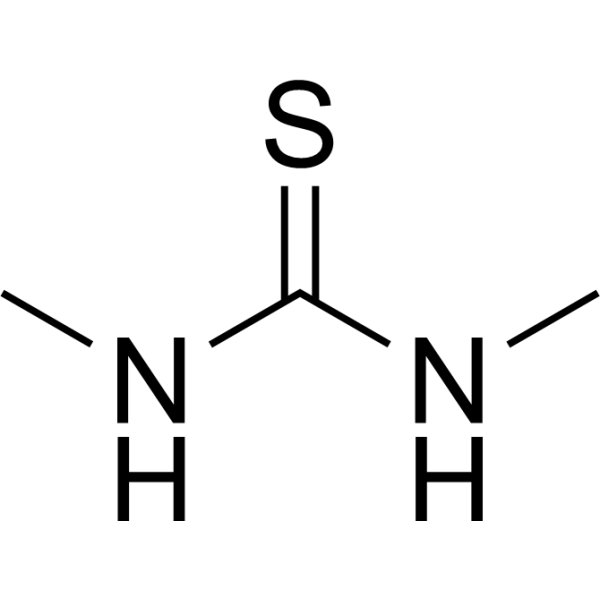
-
- HY-144743
-
|
|
Phosphodiesterase (PDE)
|
Others
|
|
ATX inhibitor 12 (compound 20) is an orally active and potent ATX (autotaxin) inhibitor, with an IC50 of 1.72 nM. ATX inhibitor 12 effectively alleviates lung structural damage with fewer fibrotic lesions at an oral dose of 60 mg/kg in C57Bl/6J mice. ATX inhibitor 12 can be uesd for idiopathic pulmonary fibrosis (IPF) research .
|
-
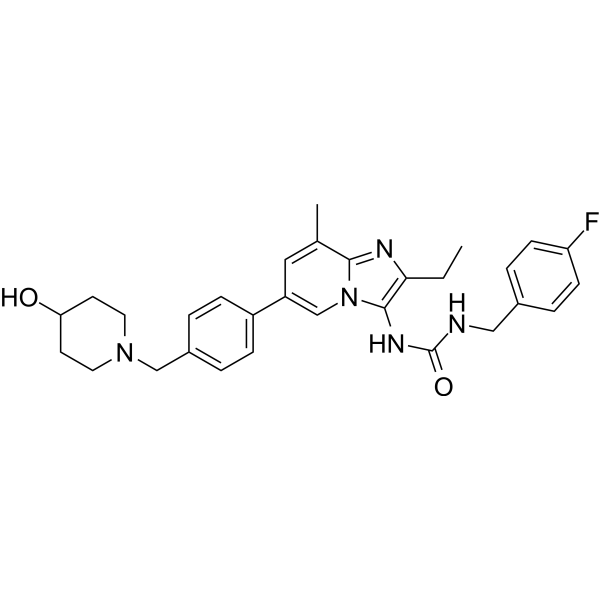
-
- HY-124304
-
|
LOE-908
|
TRP Channel
SARS-CoV
|
Neurological Disease
|
|
Pinokalant is a broad-spectrum and non-selectivecation channel inhibitor. Pinokalant significantly reduces cortical infarct volume. Pinokalant o improves the metabolic and electrophysiologic status of the ischemic penumbra. Pinokalant reduces lesion size on magnetic resonance images in the acute phase following middle cerebral artery occlusion in rats. Pinokalant has the potential for the research of stroke. Pinokalant also shows anti-SARS-CoV-2 activity .
|
-
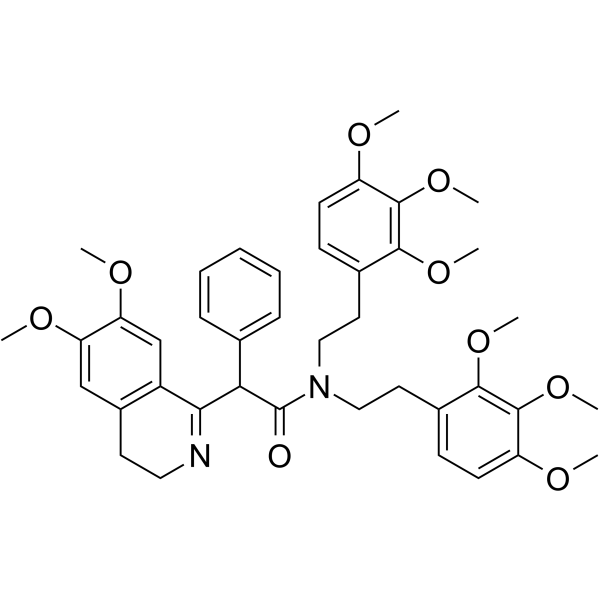
-
- HY-P99590
-
|
ACE-011
|
TGF-β Receptor
|
Inflammation/Immunology
Cancer
|
|
Sotatercept (ACE-011) is a soluble activin receptor 2A (ACVR2A) type IgG Fc fusion protein. Sotatercept combines activin and growth differentiation factor to try to restore the balance between growth promotion and growth inhibition signal pathways. Sotatercept has potential application in pulmonary arterial hypertension, anemia, bone loss, erythropoiesis, multiple myeloma (MM) osteolytic lesions .
|
-
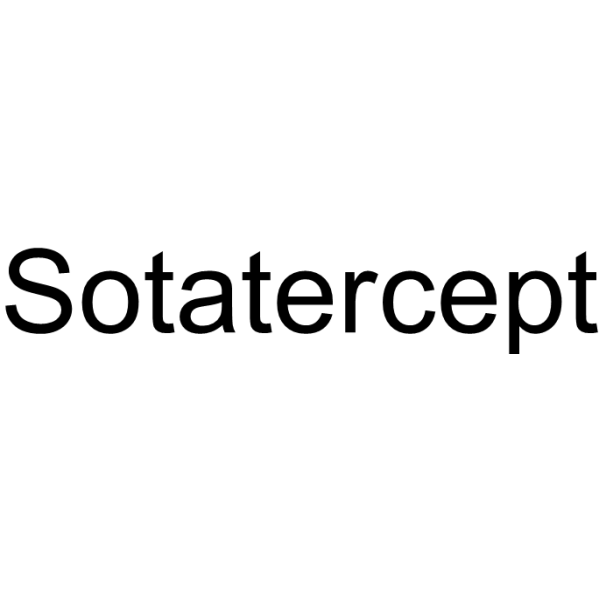
-
- HY-18340
-
|
CR8, (R)-Isomer
|
Molecular Glues
CDK
Apoptosis
|
Neurological Disease
Cancer
|
|
(R)-CR8 (CR8), a second-generation analog of Roscovitine, is a potent CDK1/2/5/7/9 inhibitor. (R)-CR8 inhibits CDK1/cyclin B (IC50=0.09 μM), CDK2/cyclin A (0.072 μM), CDK2/cyclin E (0.041 μM), CDK5/p25 (0.11 μM), CDK7/cyclin H (1.1 μM), CDK9/cyclin T (0.18 μM) and CK1δ/ε (0.4 μM). (R)-CR8 induces apoptosis and has neuroprotective effect . (R)-CR8 acts as a molecular glue degrader that depletes cyclin K .
|
-

-
- HY-18340A
-
|
CR8, (R)-Isomer trihydrochloride
|
Molecular Glues
CDK
Apoptosis
|
Neurological Disease
Cancer
|
|
(R)-CR8 (CR8) trihydrochloride, a second-generation analog of Roscovitine, is a potent CDK1/2/5/7/9 inhibitor. (R)-CR8 trihydrochloride inhibits CDK1/cyclin B (IC50=0.09 μM), CDK2/cyclin A (0.072 μM), CDK2/cyclin E (0.041 μM), CDK5/p25 (0.11 μM), CDK7/cyclin H (1.1 μM), CDK9/cyclin T (0.18 μM) and CK1δ/ε (0.4 μM). (R)-CR8 trihydrochloride induces apoptosis and has neuroprotective effect . (R)-CR8 trihydrochloride acts as a molecular glue degrader that depletes cyclin K .
|
-
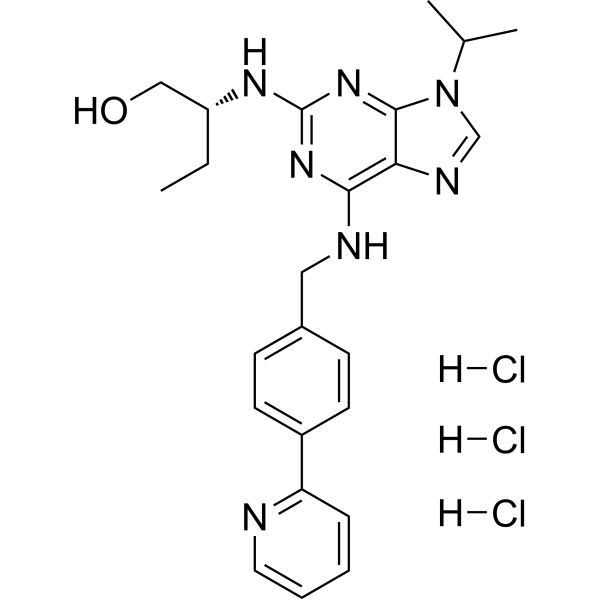
- HY-D0220
-
|
Toluidine Blue O
|
Fluorescent Dye
|
Cancer
|
|
Toluidine Blue (Toluidine Blue O) is an alkaline quinonimine dye (vivo dye) with high affinity for acidic tissue components, staining nuclei blue and polysaccharides purple. Toluidine Blue shows heterostaining properties for mast cells, mucins and chondrocytes. Toluidine Blue can stain different components of plant tissues and cells in different colours. Toluidine Blue is also used as a diagnostic aid to identify malignant lesions, such as cancer .
|
-

- HY-115567
-
|
1-(β-D-2-Deoxyribofuranosyl)-5-nitroindole
|
Apoptosis
|
Cancer
|
|
5-NIdR (1-(β-D-2-Deoxyribofuranosyl)-5-nitroindole), an artificial nucleoside, exhibits the ability to inhibit the replication of DNA lesions generated by Temozolomide (HY-17364). 5-NIdR induces cancer cells apoptosis and arrests cell cycle at G0 phase. 5-NIdR enhances Temozolomide anti-tumor efficacy in murine glioblastoma model .
|
-
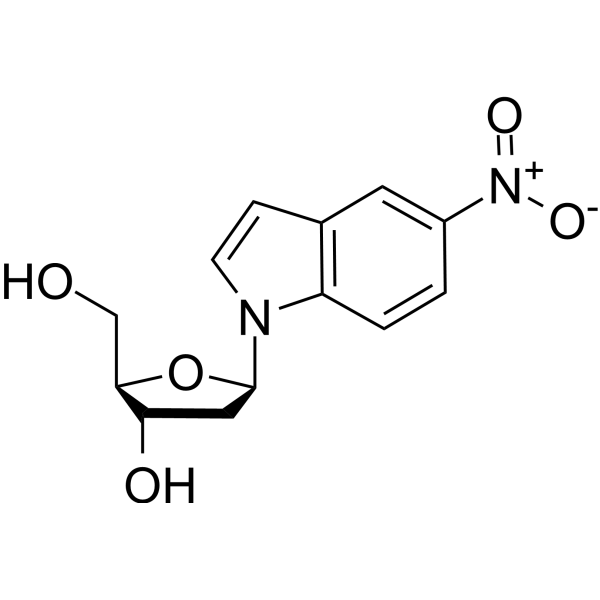
- HY-124748A
-
|
|
Protease Activated Receptor (PAR)
Apoptosis
|
Inflammation/Immunology
|
|
ENMD-1068 hydrochloride is a selective protease-activated receptor 2 (PAR2) antagonist. ENMD-1068 hydrochloride reduces hepatic stellate cell activation and collagen expression by inhibiting TGF-β1/Smad signaling. ENMD-1068 hydrochloride also inhibits the proliferation of endometrial cells and induces apoptosis of epithelial cells in the lesion. ENMD-1068 hydrochloride can be used in the study of endometriosis and liver fibrosis .
|
-

- HY-124748
-
|
|
Protease Activated Receptor (PAR)
Apoptosis
|
Inflammation/Immunology
|
|
ENMD-1068 is a selective protease-activated receptor 2 (PAR2) antagonist. ENMD-1068 reduces hepatic stellate cell activation and collagen expression by inhibiting TGF-β1/Smad signaling. ENMD-1068 also inhibits the proliferation of endometrial cells and induces apoptosis of epithelial cells in the lesion. ENMD-1068 can be used in the study of endometriosis and liver fibrosis .
|
-

- HY-130502
-
|
Cholesterol beta-epoxide
|
Biochemical Assay Reagents
|
Others
|
|
Cholesterol 5beta,6beta-epoxide is an oxidative metabolite of cholesterol formed by free-radical and non-radical oxidation of cholesterol at the 5,6 double bond. Induces lactate dehydrogenase (LDH) release and apoptosis in macrophage-differentiated U937 cells. Cholesterol 5beta,6beta-epoxide has been found in human fatty streaks and advanced atherosclerotic lesions, but not in normal aortic tissue .
|
-
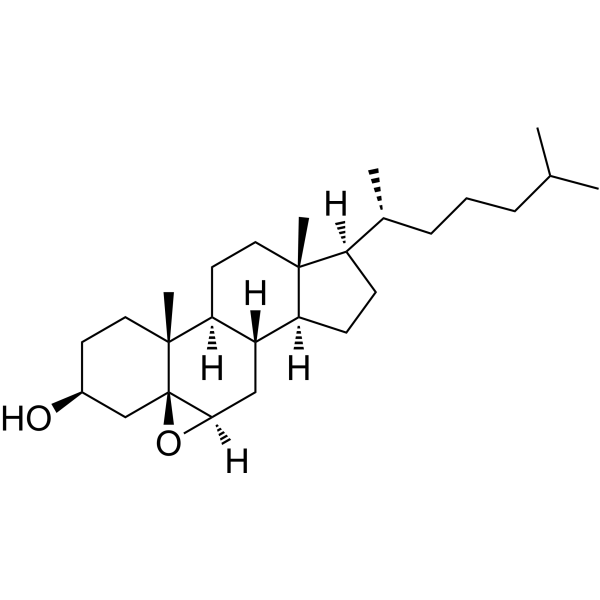
- HY-155505
-
|
|
Aryl Hydrocarbon Receptor
|
Inflammation/Immunology
|
|
AHR agonist 4 (compound 24e) is an agonist of Aryl hydrocarbon receptor (AHR), assocaited with the immune balance of Th17/22 and Treg cells. AHR agonist 4 serves as a lead compound for anti-psoriasis drug, alleviates imiquimod (IMQ)-induced psoriasis-like skin lesion . AHR agonist 4 is a click chemistry reagent, it contains an Alkyne group and can undergo copper-catalyzed azide-alkyne cycloaddition (CuAAc) with molecules containing Azide groups.
|
-
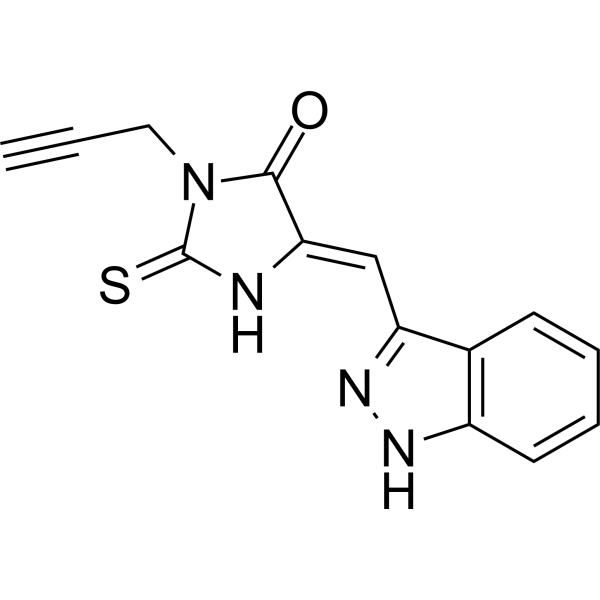
- HY-145051
-
|
|
HBV
|
Infection
|
|
HBV-IN-8 is a potent HBV inhibitor with an EC50 of 287.9 nM (WO2021213445A1, compound 13) .
|
-

- HY-145049
-
|
|
HBV
|
Infection
|
|
HBV-IN-6 is a potent HBV inhibitor with an EC50 of 44 nM (WO2021213445A1, compound 3) .
|
-
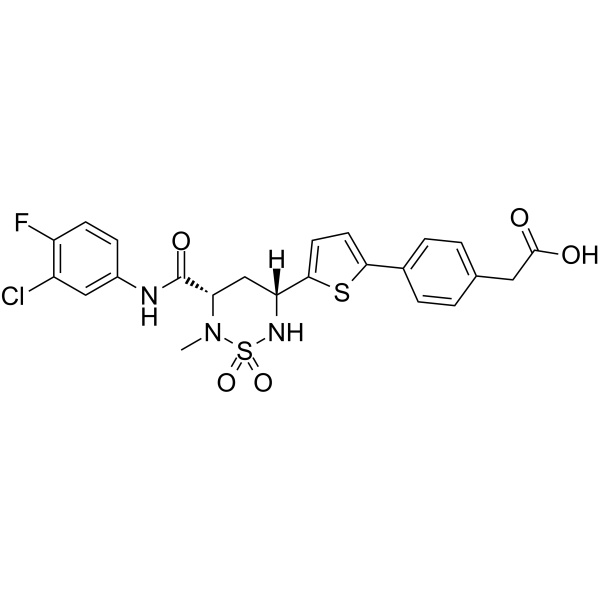
- HY-145050
-
|
|
HBV
|
Infection
|
|
HBV-IN-7 is a potent HBV inhibitor with an EC50 of 7 nM (WO2021213445A1, compound 5) .
|
-
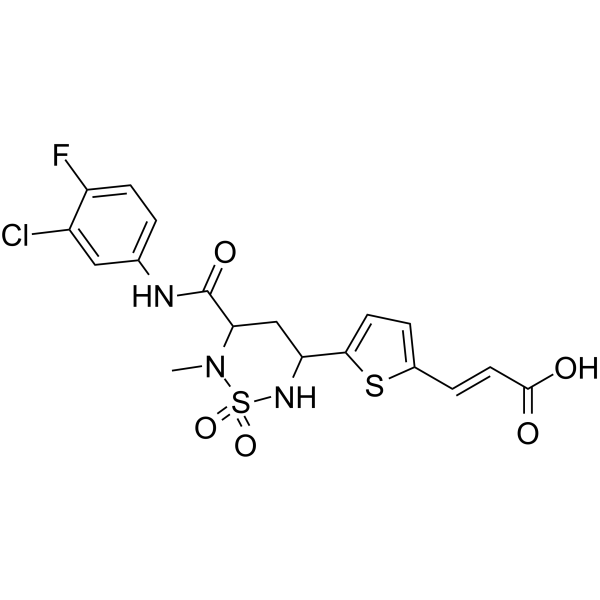
- HY-123900
-
-
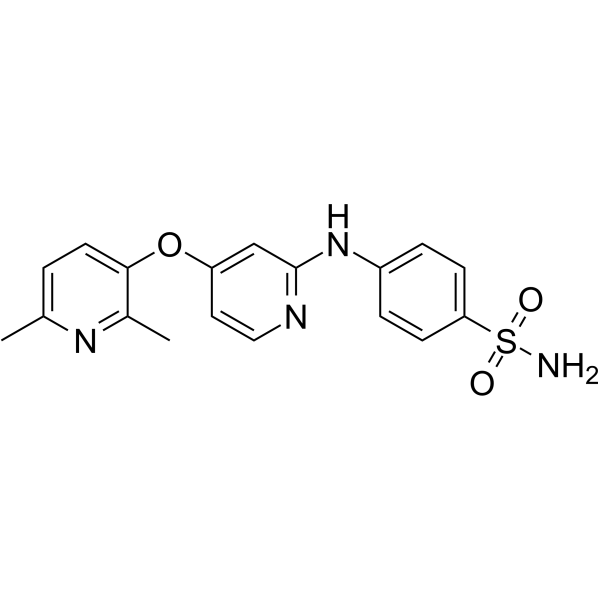
- HY-D0220A
-
|
Toluidine Blue O (purity 36%)
|
Fluorescent Dye
|
Others
|
|
Toluidine Blue (Toluidine Blue O) purity 36% is an alkaline quinonimine dye (vivo dye) with high affinity for acidic tissue components, staining nuclei blue and polysaccharides purple. Toluidine Blue purity 36% shows heterostaining properties for mast cells, mucins and chondrocytes. Toluidine Blue purity 36% can stain different components of plant tissues and cells in different colours. Toluidine Blue purity 36% is also used as a diagnostic aid to identify malignant lesions, such as cancer .
|
-
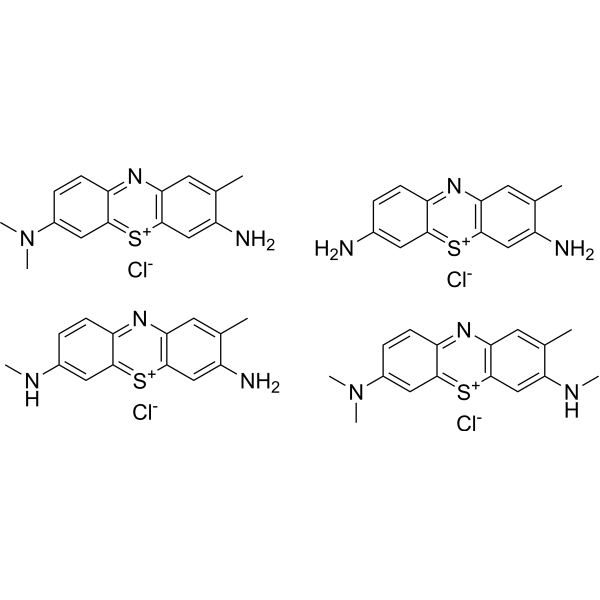
- HY-120251A
-
|
AIT-082
|
Reactive Oxygen Species
|
Neurological Disease
|
|
Leteprinim potassium (AIT-082), a purine analog, is a neuroprotective agent and cognitive enhancer. Leteprinim potassium is a hypoxanthine derivative neurotrophic agent. Leteprinim potassium can induce brain-derived neurotrophic factor (BDNF) mRNA production following spinal cord lesions, and nerve growth factor (NGF) mRNA production in basal forebrain. Leteprinim potassium reduces glutamate toxicity in cultured hippocampal neurons. Leteprinim potassium increases heme-oxygenase 1 and 2 mRNA levels that play role in cellular defense against reactive oxygen species .
|
-
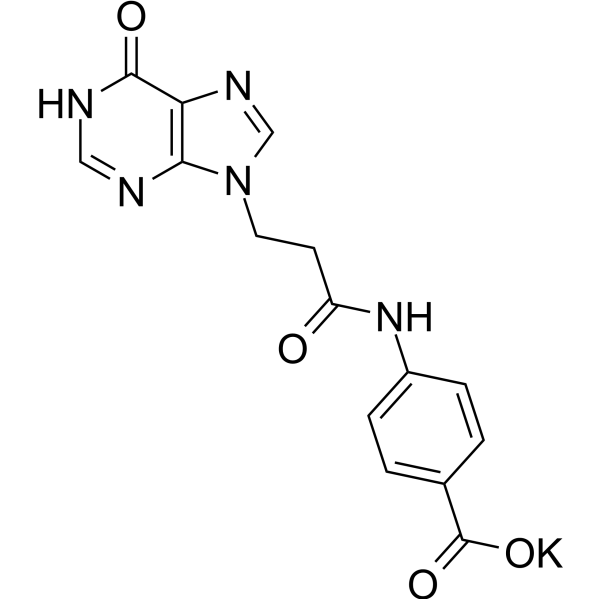
- HY-120251
-
|
AIT-082 free acid
|
Reactive Oxygen Species
|
Neurological Disease
|
|
Leteprinim (AIT-082 free acid), a purine analog, is a neuroprotective agent and cognitive enhancer. Leteprinim is a hypoxanthine derivative neurotrophic agent. Leteprinim can induce brain-derived neurotrophic factor (BDNF) mRNA production following spinal cord lesions, and nerve growth factor (NGF) mRNA production in basal forebrain. Leteprinim reduces glutamate toxicity in cultured hippocampal neurons. Leteprinim increases heme-oxygenase 1 and 2 mRNA levels that play role in cellular defense against reactive oxygen species .
|
-
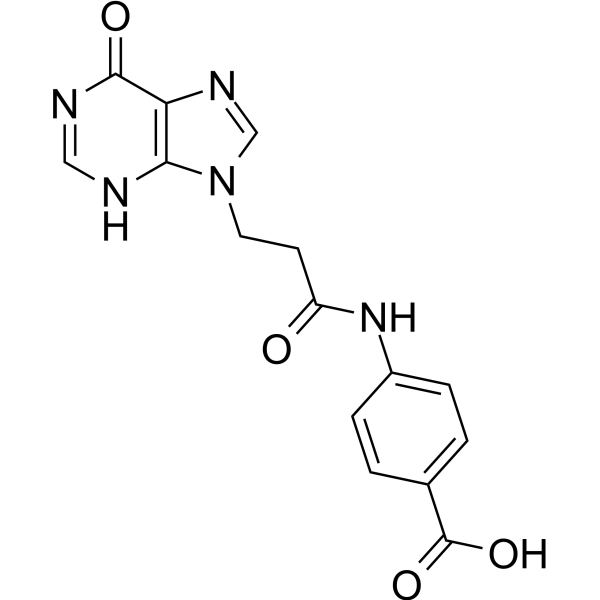
| Cat. No. |
Product Name |
Type |
-
- HY-139579
-
|
OTL 38
|
Fluorescent Dyes/Probes
|
|
Pafolacianine (OTL 38) is a fluorescent marker made of near-infrared dye used in detecting tumor lesions during surgical procedures. Pafolacianine excites at 774 to 775 nm and emits at 794 to 796 nm .
|
-
- HY-D0220A
-
|
Toluidine Blue O (purity 36%)
|
Dyes
|
|
Toluidine Blue (Toluidine Blue O) purity 36% is an alkaline quinonimine dye (vivo dye) with high affinity for acidic tissue components, staining nuclei blue and polysaccharides purple. Toluidine Blue purity 36% shows heterostaining properties for mast cells, mucins and chondrocytes. Toluidine Blue purity 36% can stain different components of plant tissues and cells in different colours. Toluidine Blue purity 36% is also used as a diagnostic aid to identify malignant lesions, such as cancer .
|
-
- HY-D1494
-
|
|
Fluorescent Dyes/Probes
|
|
FSB is a fluorescent dye that can be used to detect filamentous tau and to label human amyloid lesions with high sensitivity and specificity (excitation: 390 nm, emission: 520 nm) .
|
| Cat. No. |
Product Name |
Type |
-
- HY-157916
-
|
Aldehyde reactive probe
|
Biochemical Assay Reagents
|
|
ARP (Aldehyde reactive probe) is an aldehyde reactive probe for detecting abasic site (common DNA lesions and intermediates in mutagenesis and carcinogenesis) in DNA, which specificially tags AP site with biotin residues. ARP is highly sensitive with a femtomolar-level basic site detection capabilities (less than one site per 10 4 nucleotides) .
|
-
- HY-130502
-
|
Cholesterol beta-epoxide
|
Biochemical Assay Reagents
|
|
Cholesterol 5beta,6beta-epoxide is an oxidative metabolite of cholesterol formed by free-radical and non-radical oxidation of cholesterol at the 5,6 double bond. Induces lactate dehydrogenase (LDH) release and apoptosis in macrophage-differentiated U937 cells. Cholesterol 5beta,6beta-epoxide has been found in human fatty streaks and advanced atherosclerotic lesions, but not in normal aortic tissue .
|
| Cat. No. |
Product Name |
Target |
Research Area |
-
- HY-P1555
-
|
Adrenocorticotropic Hormone (1-13)
|
Peptides
|
Inflammation/Immunology
|
|
ACTH (1-13) is a 13-aa peptide, with cytoprotective effects in the model of ethanol induced gastric lesions in rats.
|
-
- HY-P5890
-
-
- HY-P4085
-
|
|
Peptides
|
Cancer
|
|
AGR is a peptide. AGR recognizes lymphatic vessels in fully developed prostate tumors but not in the pre-malignant lesions .
|
| Cat. No. |
Product Name |
Target |
Research Area |
-
- HY-P99590
-
|
ACE-011
|
TGF-β Receptor
|
Inflammation/Immunology
Cancer
|
|
Sotatercept (ACE-011) is a soluble activin receptor 2A (ACVR2A) type IgG Fc fusion protein. Sotatercept combines activin and growth differentiation factor to try to restore the balance between growth promotion and growth inhibition signal pathways. Sotatercept has potential application in pulmonary arterial hypertension, anemia, bone loss, erythropoiesis, multiple myeloma (MM) osteolytic lesions .
|
-
- HY-P99691
-
| Cat. No. |
Product Name |
Category |
Target |
Chemical Structure |
| Cat. No. |
Product Name |
Chemical Structure |
-
- HY-W013812S
-
|
|
Ethyl linoleate- 13C18 is the 13C labeled Ethyl linoleate. Ethyl linoleate inhibit the development of atherosclerotic lesions and the expression of inflammatory mediators[1].
|
-

-
- HY-W013812S2
-
|
|
|
Ethyl linoleate-d2 (Linoleic Acid ethyl ester-d2; Mandenol-d2) is the deuterium labeled Ethyl linoleate (HY-W013812). Ethyl linoleate (Linoleic Acid ethyl ester) inhibit the development of atherosclerotic lesions and the expression of inflammatory mediators .
|
-

-
- HY-17447SA
-
|
|
|
Tranylcypromine-d5 (hydrochloride) is a deuterium labeled (rel)-Tranylcypromine hydrochloride. Tranylcypromine hydrochloride is an irreversible, nonselective monoamine oxidase (MAO) inhibitor used in the treatment of depression. Tranylcypromine hydrochloride is also a lysine-specific demethylase 1 (LSD1) inhibitor, suppresses lesion growth and improves generalized hyperalgesia in mouse with induced endometriosis[1][2].
|
-

| Cat. No. |
Product Name |
|
Classification |
-
- HY-155505
-
|
|
|
Alkynes
|
|
AHR agonist 4 (compound 24e) is an agonist of Aryl hydrocarbon receptor (AHR), assocaited with the immune balance of Th17/22 and Treg cells. AHR agonist 4 serves as a lead compound for anti-psoriasis drug, alleviates imiquimod (IMQ)-induced psoriasis-like skin lesion . AHR agonist 4 is a click chemistry reagent, it contains an Alkyne group and can undergo copper-catalyzed azide-alkyne cycloaddition (CuAAc) with molecules containing Azide groups.
|
Your information is safe with us. * Required Fields.
Inquiry Information
- Product Name:
- Cat. No.:
- Quantity:
- MCE Japan Authorized Agent:







































































